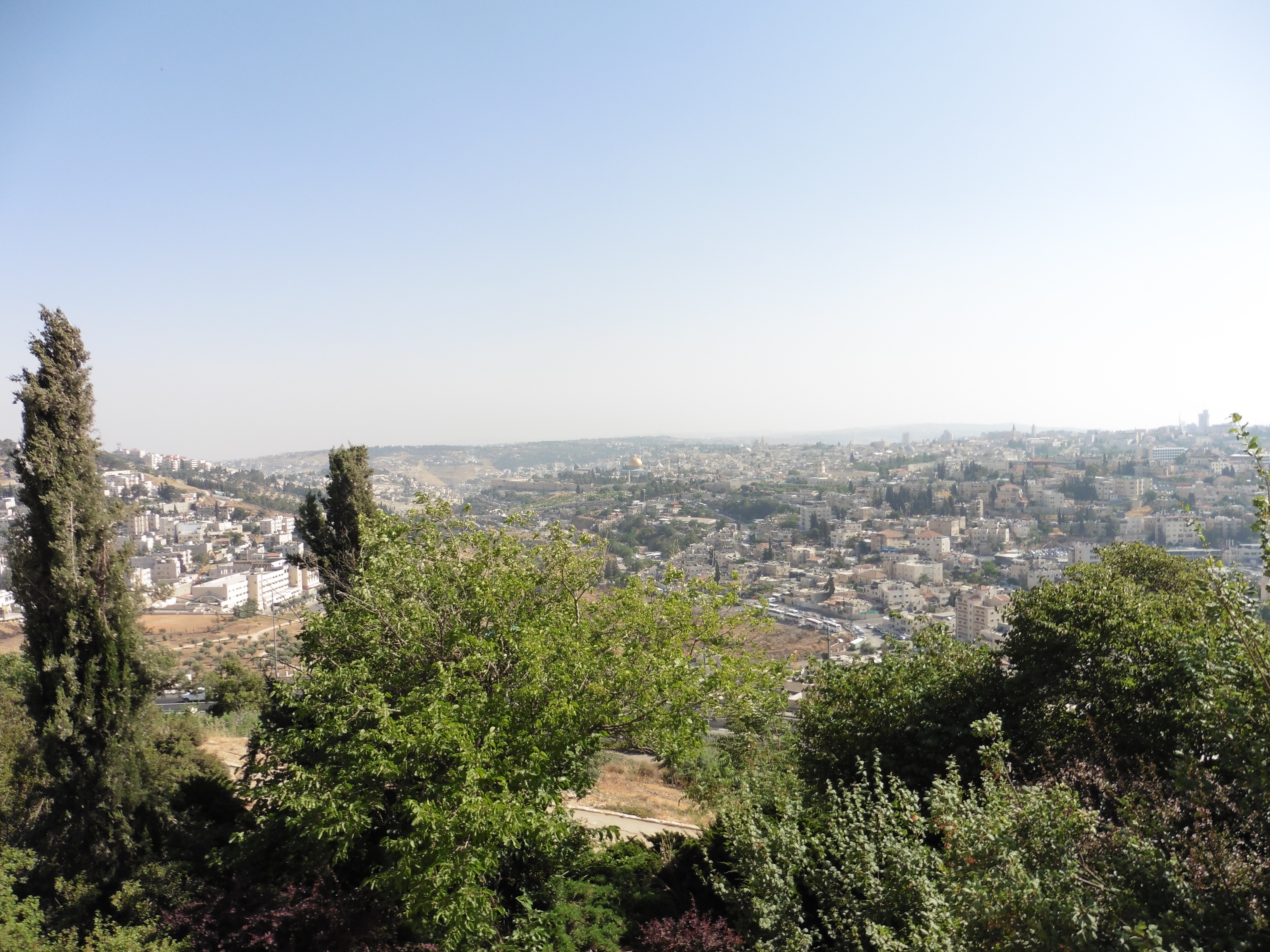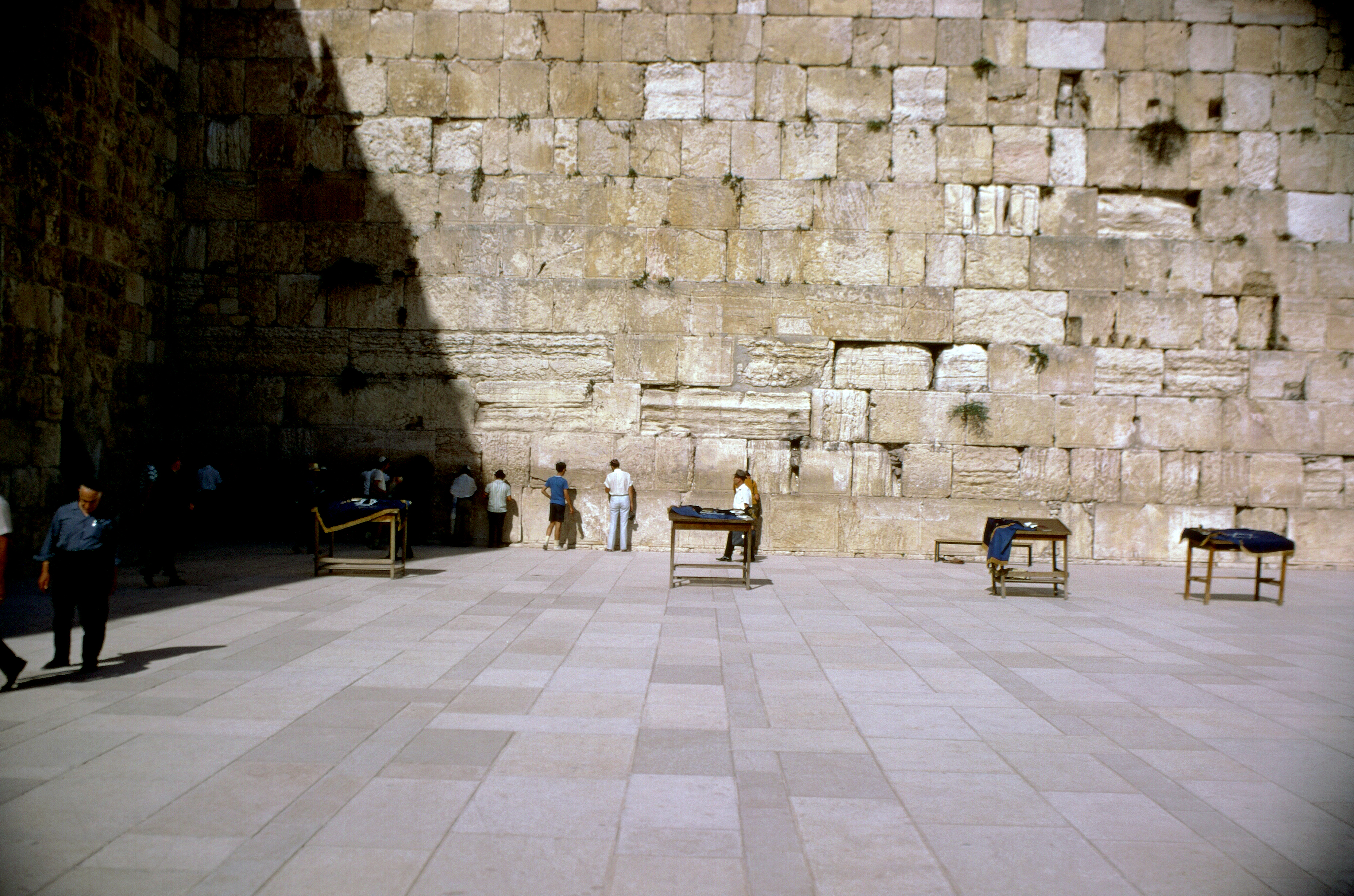
On the afternoon of Tuesday, June 9th, 2015, we proceeded through the West Bank to Jerusalem.
As we headed toward Mt. Scopus, our guide put on Yerusalayim Shel Zahav, written in 1967. The song was written by Naomi Shemer, commissioned by Mayor Teddy Kollek, and apparently unintentionally inspired by a Basque lullaby. The song was performed for the first time on May 15th, and on June 7th, after the Jordanians retreated, eastern Jerusalem and the Old City was under the control of the IDF. Jews, who had been a presence in the city for many generations, had been forced out of the Old City in 1948 when the Jordanians took over. When Shemer heard that the song was being sung at the Western Wall, she added a verse to the song.
It is said that when Jews were not allowed to enter Jerusalem by the city authorities, they used to come to Mt. Scopus and look at the city. Here, we opened a bottle of grape juice to commemorate the occasion.

We then proceeded to the hotel, the Dan Panorama Jerusalem. Like it’s counterpart in Tel Aviv, this was a middle-of-the-road hotel in a good location, not far from the Old City. We didn’t want a big meal, so we took a walk down to Ben Yehuda Street in search of some American food. It marked the first time I have had a McDonald’s hamburger. There are 180 McDonald’s in Israel, and 50 of them are kosher. The first opened in 1993, and the first kosher one in 1995.
Wednesday, June 10th, 2015
The tour group was nice enough to remember it was my birthday, and wished me a Happy Birthday. Earlier in the week, at Kibbutz Lavi, another member had a birthday and they’d arranged for everyone to sing. Alas, no group meals this day, therefore this was not an option. But heading to the Old City on my birthday…I suppose that made up for it.
The day started with visiting the Kotel…the Western Wall. On Saturday, June 10, 1967…the last day of the Six Day War, the residents of the Moroccan Quarter were evacuated and the section destroyed to expand the area in front of the Western Wall. While this was a controversial decision, the official reasoning was that the area was a slum, and the Israeli government had compensated the residents and resettled them in better housing conditions. Jews had been barred from the area from 1948-1967, and outbreaks of violence at the wall had been an issue dating back to the 1920s. Jews had, in fact, been trying to buy the area around the wall since 1918 to establish a permanent prayer site.



This is the Western Wall as it appears today. It has changed since coming under Israeli control. On the day we were there, they were preparing for a celebration. A new torah was being presented to the wall. From what I understand, there is a large ark of torahs at the wall. There was even a group of young schoolchildren practicing a song for the occasion.




I could write for many more hours on the issues regarding the Old City, the Western Wall, the mosque above the wall…but this is a travel report. I’m trying to, while not ignoring the politics of it, not get sucked in that direction too much. Even within the Jewish community, the Wall is administered under Orthodox rules of gender separation and modesty. There are informal volunteers who will chastise those who do not act according to those rules.
A short distance along the wall, provisions have been made for an egalitarian prayer site near Robinson’s arch. It wasn’t until 2013 that a dedicated area was completed with access as all hours, as the original area was within the confines of the Jewish Archaeological Park.
There have been extension excavations around the Western Wall, and the Temple Mount, which have revealed a great deal about the history of the area. We toured the tunnels beneath the Western Wall, which had been relocated from where I recall them being in 1999. The excavations had been connected to the Hasmonean Water Tunnels, ending under the Convent of the Sisters of Zion, where the Sisters would not permit exit, requiring a turnaround. I recall walking through the tunnels and exiting elsewhere in 1999, but this time, we returned to the entrance by the Western Wall. In 1996, Benjamin Netanyahu authorized the creation of an exit leading to the Via Dolorosa, in the Muslim Quarter. This led to multiple riots at the time, and in 1999, the rule was we had to be escorted back by an armed soldier.
The size of the stones both above and below is amazing. All these were hauled into place without modern construction equipment. The newer rebuilt portions at the top date from a later period, and do not demonstrate the massive skill it must have taken to get these into place.

This is the Southwestern corner of the Temple. The stones sticking out on the western side is Robinson’s arch, the support for a massive staircase the once stood here, dating back to the time of Herod the Great. You get a perspective from this angle the proximity to the Al Aqsa Mosque and the Dome of the Rock, at the top.
The Southern Wall is where you can see the excavation of an enormous flight of steps excavated after 1967, that led, via the Hulda Gates, up to the Temple Mount. A series of Umayyad administration buildings and palaces were uncovered just outsiide, which form the rest of the Archaeological park.
I suppose the Western Wall and its surroundings deserve their own part in this series. This part contained more pictures than previous.
Next time in Part 8…More of the Old City..
Very informative..enjoyed!